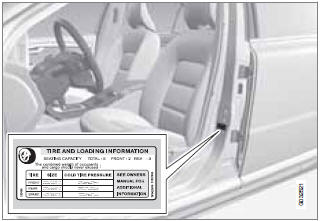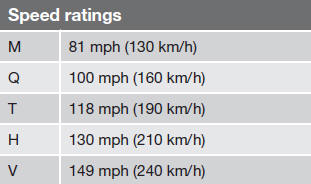Volvo XC60: Tire inflation
Inflation placard

Tire inflation placard
Tire inflation
Check tire inflation pressure regularly.
See the tire inflation table on page 291. A tire inflation pressure placard is also located on the driver's side B-pillar (the structural member at the side of the vehicle, at the rear of the driver's door opening). This placard indicates the designation of the factory-mounted tires on your vehicle, as well as load limits and inflation pressure.
NOTE
• The placards shown indicate inflation
pressure for the tires installed on the
vehicle at the factory only.
• A certain amount of air seepage from
the tires occurs naturally and tire pressure
fluctuates with seasonal changes
in temperature. Always check tire pressure
regularly.
• Use a tire gauge to check the tire inflation pressure, including the spare, at least once a month and before long trips. You are strongly urged to buy a reliable tire pressure gauge, as automatic service station gauges may be inaccurate.
• Use the recommended cold inflation pressure for optimum tire performance and wear.
• Under-inflation or over-inflation may cause uneven treadwear patterns.
WARNING
• Under-inflation is the most common
cause of tire failure and may result in
severe tire cracking, tread separation,
or "blow-out," with unexpected loss of
vehicle control and increased risk of
injury.
• Under-inflated tires reduce the load carrying
capacity of your vehicle.
When weather temperature changes occur, tire inflation pressures also change. A 10-degree temperature drop causes a corresponding drop of 1 psi (7 kPa) in inflation pressure. Check your tire pressures frequently and adjust them to the proper pressure, which can be found on the vehicle's tire information placard or certification label.
Checking tire pressure
Cold tires
Inflation pressure should be checked when the tires are cold.
The tires are considered to be cold when they have the same temperature as the surrounding (ambient) air.
This temperature is normally reached after the vehicle has been parked for at least 3 hours.
After driving a distance of approximately 1 mile (1.6 km), the tires are considered to be hot. If you have to drive farther than this distance to pump your tire(s), check and record the tire pressure first and add the appropriate air pressure when you get to the pump.
If checking tire pressure when the tire is hot, never "bleed" or reduce air pressure. The tires are hot from driving and it is normal for pressures to increase above recommended cold pressures. A hot tire at or below recommended cold inflation pressure could be significantly under-inflated.
To check inflation pressure:
1. Remove the cap from the valve on one tire, then firmly press the tire gauge onto the valve.
2. Add air to reach the recommended air pressure.
3. Replace the valve cap.
4. Visually inspect the tires to make sure there are no nails or other objects embedded that could puncture the tire and cause an air leak.
5. Check the sidewalls to make sure there are no gouges, cuts, bulges or other irregularities.
6. Repeat this procedure for each tire, including the spare.
NOTE
• If you overfill the tire, release air by
pushing on the metal stem in the center
of the valve. Then recheck the pressure
with your tire gauge.
• Some spare tires require higher inflation pressure than the other tires. Consult the tire inflation pressure table on page 291 or see the inflation pressure placard.
Tire ratings
Speed ratings
The speed ratings in the table translate as follow:


Load ratings
See page 292 for an explanation of the load rating on the sidewall of the tire.
Inflation pressure
Tire inflation pressure table
The following tire pressures are recommended by Volvo for your vehicle. Refer to the tire inflation placard (see page 289 for its location) for information specific to the tires installed on your vehicle at the factory.

NOTE
Please consult a Volvo retailer’s Parts
department for the most up-to-date specifications.
See also:
Control panel buttons — color screen with navigation
system (if so equipped)
Control panel buttons — color screen with navigation
system (if so equipped)
1. (brightness control) button
2. Display screen
3. MAP button*
4. NAV button*
5. TRAF button*
6. SETUP button
7. BACK button
8. TUNE/SCROLL knob
9. ...
Cockpit
Cruise control lever
Instrument cluster
Horn
PARKTRONIC warning display
Overhead control panel
Operates the climate control system
Ignition lock
Start/Stop button
Adjusts the steering wheel manually
Adjusts the steering wheel e ...

 General information
General information